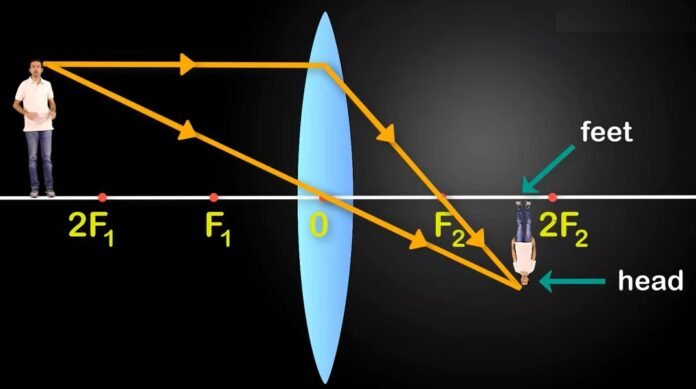Introducing Concave Lens
The physical feature of identifying a concave lens is that it is narrower in the centre and broader at the edges. A concave lens tends to diverge a ray of light; hence, it is also known as a diverging lens. The central section of a concave lens is parallel-sided glass, and a ray of light falling on it passes through it without deviating.
The upper portion of a concave lens deviates from a ray of light in the upward direction, while the lower portion of these lenses deviates from a ray of light in the downward direction. Concave lenses have various uses in your daily life. We have discussed them in the later parts of this blog.
Types of Concave Lenses
There are mainly three types of concave lenses. They are:
Plano concave lens
An optical lens that has one plain surface and one concave surface.
Convexo-concave lens
An optical lens that has a combination of a concave and a convex lens.
Double Concave lens
An optical lens that has a combination of two concave lenses.
The Concave Lens Formula
The formula for the concave lens is,
1/f = 1/v + 1/u, where
f = focal length of the lens,
v = image distance from the lens, and
u = object distance from the lens.
Uses of Concave Lens
Concave lenses are useful in our everyday life. The uses are plenty, and here are some of them:
Telescopes & Binoculars
Concave lenses function as magnifiers; they are found in binoculars and telescopes. Concave lenses facilitate object magnification. They assist telescopes and binoculars in possessing more clarity.
Eyeglasses
The eyeglasses of a person diagnosed with myopia or nearsightedness are made with concave lenses. This is one medical use of a concave lens.
Peepholes
Peepholes are an age-old security device yet used in households’ doors and walls. Peepholes allow a 360° view of the outside areas when kept an eye on it. A concave lens provides this more expansive view by reducing the object proportions.
Laser Devices
Concave lenses are commonly used in laser devices such as CD players, scanners, DVD players, medical equipment, etc. A concave lens widens the area of the laser beam when passed through it.
Recommended Articles:
Animal Kingdom Classification – Animal Phylum, Subphylum Characteristics
Animal Husbandry Poultry Farming: Methods, Disease, Breeding and Rearing
What is Abiotic Factors? Definition Examples, Types, Responses
Different Modes Of Plant Reproduction : Asexual and Sexual Reproduction
Different Ways of Taking Food or Indigestion in Human
Physics - Uses of Concave Lens FAQs
Suggest the type of mirror that should be used in these situations:
A solar-run furnace.
A car's rear/side view mirror.
The headlights of a car.
Here are the types of mirrors that should be used in these instances:
A solar-run furnace should have a concave lens to concentrate the sunlight that falls on it. It will generate the maximum heat from the sunlight.
A rear/side view mirror must provide the driver with a broad and clear visual field. A convex lens is used that produces erect, decreased, and virtual images.
A concave lens is used in a car's headlights to generate parallel light beams after reflection.
What kind of lens should be used in torches and flashlights?
A concave lens should be used in both instances. When it reflects a light beam, the concave lens will diverge the rays, distributing the reflected light over a large area.
This enables the torches and flashlights to produce enough light in the darkness. This way, the visibility of an object increases in darkness when a light beam is reflected via a concave lens.
What happens to the light rays when passes through a concave lens?
After a beam of light passes through a concave lens, the lights ray diverge, hence, a concave lens is also known as a diverging lens. When produced in the backward direction, the light rays meet at the principal axis of the lens.
The point in the principal axis of a lens, where the light rays meet when produced backwards, is known as the principal focus. Hence, the refracted rays tend to diverge from the focal point of a concave lens. The exact opposite phenomenon happens in a convex lens.
Why is the focal length of a lens so important?
The lens' focal length determines how enlarged/zoomed in the lens is.
Adjusting the focal length of a lens sets how much and what a person can see. For example, consider binoculars. If the binocular's focal length is 40mm, you can see the entire Himalayas. However, when you set the focal length to 450mm, you might only see the tip of a mountain or the trees on it.
The focal length of a lens plays a huge role in photography. To have a clear idea of the lens' focal length, you should know the object’s distance from the lens and the distance from your lens to the desired image. The parallel rays meet at a particular point known as the focal point.
What is known as the power of a lens?
The capacity of a lens to bend a beam of light after reflection from it is known as its power.
The lens with a shorter focal length tends to have more power. Hence, the relation between focal length is denoted as
f (focal length) = 1/P (power). The S.I. unit of power of a lens is 1/m or diopter. Conclusively, the power and focal length of a lens are inversely proportional.
